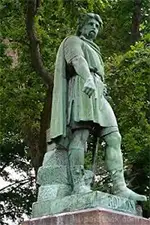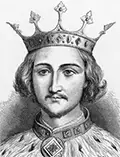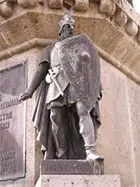Rulers of Normandy
Part 1: Early Years Rollo was a Viking warrior who in the late 9th and early 10th Centuries carved out the province of Normandy in what is now northwest France. 
He was born about 860. He left his native Scandinavia, along with a large handful of fellow warriors, in the early 10th Century, raiding England and Scotland, and then targeted Flanders and Frankish territory, besieging Paris in 885 and then Chartres about 911. Rollo made so much trouble that he eventually got Charles III of France to give him land in return for stopping the attacks. The Treaty of Saint-Clair-sur-Epte guaranteed Rollo and his men some land in what was then the province of Nuestria. The promise that Rollo made, in addition to ceasing fighting, was to convert to Christianity. In return, Charles gave his daughter Gisela in marriage to Rollo. Rollo and his men were from Norway or Denmark. (Scholars disagree on which.) The locals referred to them as Northmen, and this was how the land of Normandy got its name. Its capital was Rouen. Rollo died in the early 930s, and his son William I Longsword succeeded him as the Norman leader. William Longsword
In 935, William named Luitgarde, the daughter of Count Herbert II of Vermandois. In this, William became a friend to two men whom his father had opposed. Hugh the Great emerged at this point as the most powerful noble in the French realm. He knew that Charles the Simple had an infant son who had been spirited away to England and had grown up in the court of the Anglo-Saxon kings Edward the Elder and Æthelstan. With the throne vacant, Hugh convinced his fellow nobles to install on it the teenage son of Charles the Simple, who became Louis IV. The new king had agreed to come back after a personal promise of loyalty from William. William fought on behalf of his brother-in-law in 939, who had been the victim of an attack by Flanders. That count, Arnulf I, responded by invading Normandy. The struggle between the two powerful continued for two more years, until the death of William, killed by Arnulf's men while attending a peace conference. Richard I
The young disenfranchised duke escaped his captivity and, in 946, joined an anti-Frank coalition led by King Harold of Denmark. In the ensuing battle, Louis IV found himself on the other end of captivity and secured his own release in part by agreeing to give Richard his land back. Louis was back not long afterward, with an army led by Otto the Great, the Holy Roman Emperor; even that great force could not oust the Normans from Rouen, their capital. Theobald I, the Count of Blois, had another go at storming the castle at Rouen but was again unsuccessful. During a period of relative peace, Richard married Emma of Paris and also gained a guardian, 15-year-old Hugh Capet. They went on to have eight children together; notable among those were Richard and Emma, who was wife of the English kings Æthelred II and Canute and mother of two more, Edward the Confessor and Hardacanute. For the last several years of his life, Richard focused on shoring up his Norman realm, including building and rebuilding churches and monasteries. He died in 996, and his son became Richard II. Richard IIHis year of birth is uncertain. He became Duke of Normandy in 996, when his father, Richard I, died. The new duke was not of ruling age and so had a regent, his uncle Count Rodulf of Ivry. In his own right, Richard formed a military alliance with Robert II of France. 
Richard and Geoffrey I, Duke of Brittany made an alliance based on marriage, as Richard married Geoffrey's sister, Judith of Brittany, and Geoffrey married Richard's sister, Hawise. Richard led the defense of Normandy in an attack by English forces led by his brother-in-law, King Æthelred II, in 1000. Norman cavalry carried the day at the Battle of Val-de-Saire, on the Cotentin Peninsula. The wife of King Æthelred II was Emma, and the they had two sons, Edward and Alfred. When Sweyn Forkbeard invaded England in 1013, Emma and her sons fled to Normandy, to stay with her brother, Richard. Æthelred himself followed in time. Sweyn was on the throne only a short time before he died, and Æthelred took the opportunity to retake his throne. Sweyn's son, Canute, had decided to cut his losses in 1014 and returned home. Canute was back in 1016, and Æthelred died in the middle of the invasion. Canute forced Emma to marry him and Richard, on behalf of Normandy, to recognize Canute as King of England. Robert later attempted an invasion of England but was turned back by a sudden storm. Richard II died in 1026. Succeeding him was his oldest son, who became Richard III. Not long after assuming power, Richard had to put down a rebellion by his younger brother Robert. Richard succeeded in defeating his brother but died suddenly and his younger brother became Robert I. Next page > Later Years > Page 1 2 |
|
Social Studies for Kids
copyright 2002–2024
David White



 William had had a son before marrying Luitgarde, with whom he had no children. That son, Richard, became Duke of Normandy in 942, when he was 10. Because he was so young, Richard couldn't rule in his own name. Taking advantage of the situation was King Louis IV of France, who took Richard prisoner and divided Normandy in two, creating Upper and Lower lands. The latter he gave to Hugh the Great.
William had had a son before marrying Luitgarde, with whom he had no children. That son, Richard, became Duke of Normandy in 942, when he was 10. Because he was so young, Richard couldn't rule in his own name. Taking advantage of the situation was King Louis IV of France, who took Richard prisoner and divided Normandy in two, creating Upper and Lower lands. The latter he gave to Hugh the Great.
